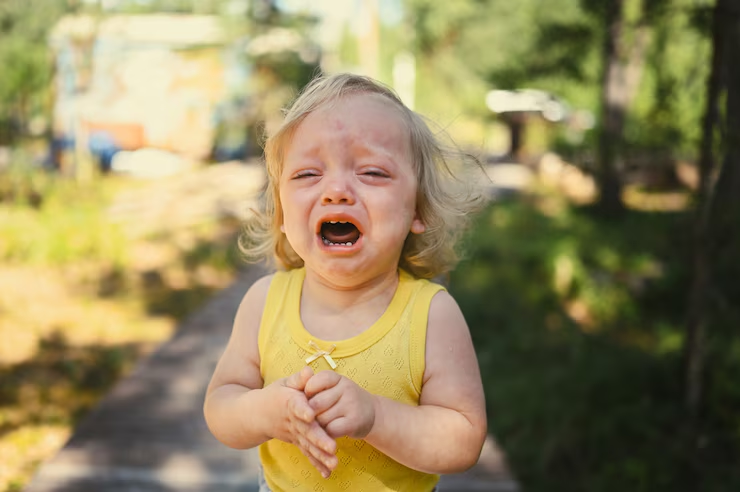Introduction: You’re Not Alone, Mama
You love your toddler deeply those snuggles, the giggles, and the curious questions that seem to never end. But then come the moments when they throw a shoe across the room, scream “NO!” on repeat, or hit you mid-meltdown at the supermarket.
And you wonder: Is this normal? Or is my toddler’s behavior becoming a real problem?
You’re not alone. Every parent hits a point where they feel overwhelmed and question their parenting. But here’s the truth: toddlerhood is supposed to be messy. Still, when behavior starts to affect your peace, your routines, or your child’s well-being, it’s time to pause, understand, and gently guide.
In this blog, we’ll unpack:
- What qualifies as a “behavior problem” in toddlers
- Root causes behind tough behavior
- How to respond with empathy not explosions
- Gentle parenting tools that actually work
- When to get help (and how to ask for it)
Let’s gently raise toddlers into emotionally healthy humans—starting with understanding their behavior without shame.
1. What Counts as a Toddler Behavior Problem?
First off tantrums, power struggles, and boundary-pushing are part of toddler development. These aren’t necessarily “problems.” But here’s when to pay closer attention:
- Aggression that escalates (hitting, biting, kicking often)
- Frequent tantrums beyond age norms (3+ major meltdowns daily at age 4+)
- Self-harming behaviors (headbanging, biting self)
- Extreme separation anxiety
- Complete resistance to basic routines (eating, sleeping, dressing)
- Inability to engage socially even in familiar settings
If these behaviors are constant and disrupting daily life, your child might need extra support.
But take a breath you’re not doing anything wrong. Your toddler isn’t broken. There’s always a why behind the behavior.
2. What’s REALLY Going On? Understanding the Root Causes
Behavior is communication. Toddlers aren’t trying to be “bad” they’re trying to express big feelings with a tiny emotional toolbox.
Here are common causes of difficult toddler behavior:
Developmental Brain Changes
Your toddler’s brain is under construction especially in the areas of self-control, impulse regulation, and empathy. Meltdowns aren’t manipulation; they’re a brain overwhelmed.
Overstimulation or Tiredness
Too much noise, lack of sleep, or changes in routine can send a toddler into sensory overload.
Emotional Needs Not Being Met
Craving attention, feeling disconnected, or dealing with stress at home? Behavior will show it.
Unrealistic Expectations
We expect toddlers to sit still, listen, and behave in adult ways. But their brains can’t always comply.
3. Don’t Take It Personally, How to Stay Grounded
It’s easy to feel triggered when your toddler lashes out. But staying calm is your superpower.
- Pause before reacting. Say in your head: “This is a child having a hard time, not giving me a hard time.”
- Take deep breaths. Model calmness they can mirror.
- Don’t match the energy. Yelling only escalates fear and aggression.
- Remind yourself: Behavior ≠ your worth as a parent.
You are not failing. You are learning. And so is your child.
4. Gentle, Real-Life Ways to Respond to Difficult Behavior
Gentle parenting doesn’t mean permissive parenting. It means guiding with respect, not fear.
Here’s how:
1. Name the Emotion
Say, “I see you’re angry. It’s okay to be angry. It’s not okay to hit.” This helps build emotional literacy.
2. Set Boundaries Without Yelling
Use calm, clear language: “I won’t let you hurt me. Let’s take a break together.”
3. Offer Connection First, Then Correction
Before correcting, offer a hug, eye contact, or sit beside them. Connection opens the door for cooperation.
4. Use the “When/Then” Method
“When we put on our shoes, then we’ll go to the park.” It sets expectations clearly.
5. Validate, Then Redirect
Say, “You’re frustrated that your toy broke. Let’s fix it together,” instead of “Stop crying.”
5. Discipline ≠ Punishment: Here’s What Actually Works
Forget time-outs, spanking, or shame-based tactics. They might stop the behavior temporarily but won’t teach anything long-term.
Try instead:
Time-Ins
Sit with your child in a calming corner. Help them breathe. Reflect on what happened.
Natural Consequences
If they throw food, the food is done. No drama, no threatsjust logical outcomes.
Routine Charts
Toddlers thrive on predictability. Visual schedules reduce power struggles.
Praise the Positive
Notice good behavior more than bad: “You waited your turn! That was kind!”
6. The Power of Repair: It’s Okay to Mess Up
Yelled today? Lost your cool? Said something you regret?
Apologize.
“Mommy was frustrated. I’m sorry I yelled. I’m learning too.”
This models humility and emotional safety. It teaches that mistakes aren’t the end they’re part of growing.
7. When to Ask for Help (And Where to Go)
If your toddler’s behavior:
- Hurts others frequently
- Interferes with daily functioning (school, sleep, relationships)
- Causes extreme emotional distress
…it may be time to talk to your pediatrician or a child psychologist.
Asking for help is strong parenting. Not weak.
You can also:
- Join gentle parenting Facebook groups
- Seek play therapy
- Follow child psychologists on Instagram
8. What Your Toddler Really Needs Most
Not perfection.
Not a constantly happy home.
Not a parent who never yells.
Your toddler needs:
- Boundaries wrapped in love
- Presence, not pressure
- A safe space to fall apart
- A parent who tries again tomorrow
And you’re already doing that just by reading this.
Final Thoughts: You’ve Got This
Toddler behavior can feel like an emotional rollercoaster and some days, you just want to get off. But you’re not alone, and you’re not powerless.
You have the strength, love, and wisdom to gently guide your child through even the toughest moments.
When your toddler’s behavior is a problem, let that be a signal not a shame. A signal to connect deeper, understand more, and hold space for growth. For both of you.
You’ve got this, mama. One meltdown, one cuddle, and one deep breath at a time.
